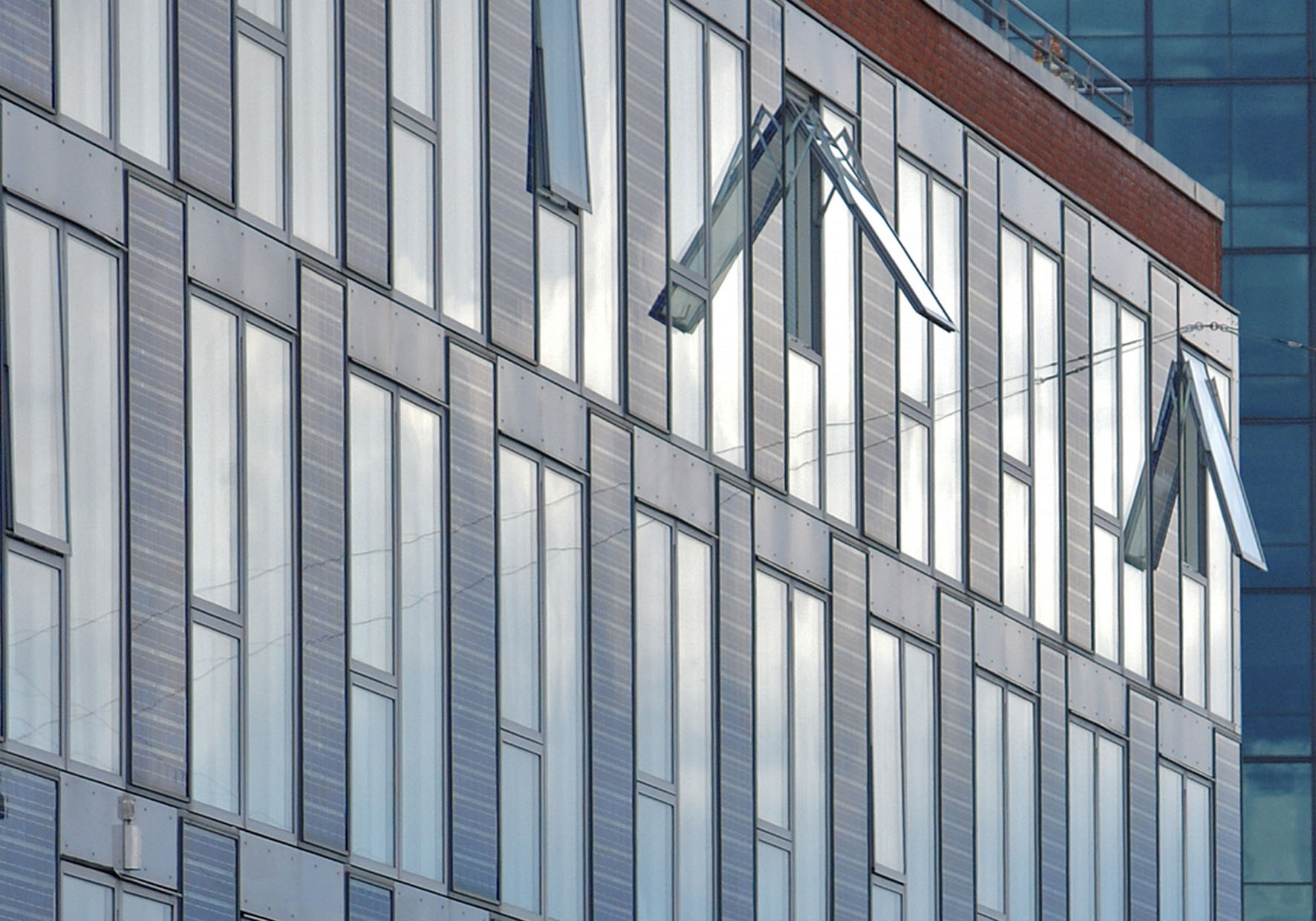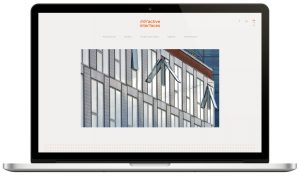
Holistic operational strategies crossing over obstacles for a large-scale qualitative integration of advanced BIPV into urban renewal processes.
This research project contributes to the Confederation’s new “Energy Strategy 2050” which requires 10 GW of photovoltaic (PV) energy. Through a holistic approach, the project proposes concrete strategies in order to overcome the obstacles to a broad quantitative and qualitative integration of buildings integrated photovoltaic systems (BIPV) during the urban renewal processes. Currently, despite technological and economic progress, only a small percentage of the solar electricity potential is exploited by BIPV systems (facade or roof elements).
The research project analyzes the various barriers which tend to limit the massive implementation of BIPV on the architectural and urban scales. It also proposes alternative solutions developed through holistic approaches linked to industrial production, constructive and legal constraints, architectural quality and socio-cultural aspects. From a sustainability perspective, the development of new adapted solutions takes into account diverse criteria (energy, comfort, LCA, costs, esthetics, costs of electricity and grid connection). The integration of test-applications carried out on representative sites, offers an attractive link between the development of industrial elements and the generation of operational knowledge directly integrated into new adapted solutions and design strategies.
Research Partners
Laboratory of Architecture and Sustainable Technologies (LAST), PV-LAB, LIPID, CSEM, ISAAAC (SUPSI), CC EASE (HSLU), IBI (ETHZ), IWÖ (FHSG), IEnergy (EIA-FR), econcept AG.
Research Team LAST
Prof. Emmanuel Rey, Dr. Sophie Lufkin, Dr. Sergi Aguacil
Funding
Swiss National Science Foundation (SNSF) – National Research Program NRP 70
Website

Thesis
Urban planning support based on the photovoltaic potential of buildings: a multi-scenario ranking system
G. Peronato / M. Andersen; E. Rey (Dir.)
Lausanne, EPFL, 2019. Architectural Design Strategies for Building-Integrated Photovoltaics in residential building renovation processes
S. Aguacil Moreno / E. Rey (Dir.)
Lausanne, EPFL, 2019. Main publications
Evaluation of a Portable fMRI Compatible Robotic Wrist Interface
I. Farkhatdinov; A. Garnier; T. Arichi; H. Bleuler; E. Burdet
2022. 44th Annual International Conference of the IEEE Engineering in Medicine and Biology Society, Glasgow, UK, 2022-07-11 – 2022-07-15. DOI : 10.1109/EMBC48229.2022.9871667. Molecular scale description of interfacial mass transfer in phase separated aqueous secondary organic aerosol
M. Lbadaoui-Darvas; S. Takahama; A. Nenes
Atmospheric Chemistry And Physics. 2021. Vol. 21, num. 23, p. 17687 – 17714. DOI : 10.5194/acp-21-17687-2021. Accelerating the Design of Photocatalytic Surfaces for Antimicrobial Application: Machine Learning Based on a Sparse Dataset
H. Park; E. T. Bentria; S. Rtimi; A. Arredouani; H. Bensmail et al.
Catalysts. 2021. Vol. 11, num. 8, p. 1001. DOI : 10.3390/catal11081001. Characterizing the Reserve Provision Capability Area of Active Distribution Networks: A Linear Robust Optimization Method
M. Kalantar Neyestanaki; F. Sossan; M. Bozorg; R. Cherkaoui
IEEE Transactions on Smart Grid. 2021. Vol. 11, num. 3, p. 2464 – 2475. DOI : 10.1109/TSG.2019.2956152. Phonon-Ion Interactions: Designing Ion Mobility Based on Lattice Dynamics
S. Muy; R. Schlem; Y. Shao-Horn; W. G. Zeier
Advanced Energy Materials. 2021. p. 2002787. DOI : 10.1002/aenm.202002787. Exploring the Robustness of Building-Integrated Photovoltaics Renovation Scenarios to Climate Change Perspectives: Results for a multi-family building in the Swiss context
S. Aguacil Moreno; É. Nault; E. Rey
2020. 35th Passive and Low Energy Architecture PLEA 2020 Conference, La Coruña, Galicia, Spain, September 1-3, 2020. p. 1233 – 1238. DOI : 10.17979/spudc/9788497497947. Active surfaces selection method for building-integrated photovoltaics (BIPV) in renovation projects based on self-consumption and self-sufficiency
S. Aguacil Moreno; S. Lufkin; E. Rey
Energy & Buildings. 2019. Vol. 193, p. 15 – 28. DOI : 10.1016/j.enbuild.2019.03.035. Influence of design‐decisions on the energy performance of renovation projects with building‐integrated photovoltaics: Results for a 1968 residential archetype in Neuchâtel (Switzerland)
S. Aguacil Moreno; S. Lufkin; E. Rey
2018. PLEA 2018: Smart and Healthy Within the Two-Degree Limit, Hong-Kong, China, December 10-12, 2018. p. 598 – 603. Assessment of the Building‐Integrated Photovoltaic potential in urban renewal processes in the Swiss context: Complementarity of urban‐ and architectural‐scale analyses
S. Aguacil Moreno; G. Peronato; M. Andersen; E. Rey
2018. PLEA 2018: Smart and Healthy Within the Two-Degree Limit, Hong-Kong, China, December 10-12, 2018. p. 347 – 352. Assessing the photovoltaic potential of flat roofs: Insights from the analysis of optimised array arrangements
G. Peronato; S. Aguacil Moreno; A. Legrain; E. Rey; M. Andersen
2018. PLEA 2018: Smart and Healthy Within the Two-Degree Limit, Hong-Kong, China, December 10-12, 2018. p. 1032 – 1033. 3D model discretization in assessing urban solar potential: the effect of grid spacing on predicted solar irradiation
G. Peronato; E. Rey; M. Andersen
Solar Energy. 2018. Vol. 176, p. 334 – 349. DOI : 10.1016/j.solener.2018.10.011. A toolkit for multi-scale mapping of the solar energy-generation potential of buildings in urban environments under uncertainty
G. Peronato; P. Rastogi; E. Rey; M. Andersen
Solar Energy. 2018. Vol. 173, p. 861 – 874. DOI : 10.1016/j.solener.2018.08.017. Application of the cost-optimal methodology to urban renewal projects at the territorial scale based on statistical data—A case study in Spain
S. Aguacil Moreno; S. Lufkin; E. Rey; A. Cuchi
Energy and Buildings. 2017. Vol. 144, p. 42 – 60. DOI : 10.1016/j.enbuild.2017.03.047. Plug&Play brain-computer interfaces for effective active and assisted living control
N. Mora; I. De Munari; P. Ciampolini; J. d. R. Millán
Medical and Biological Engineering and Computing. 2017. Vol. 55, num. 8, p. 1339 – 1352. DOI : 10.1007/s11517-016-1596-4. Integrated design strategies for renovation projects with Building-Integrated Photovoltaics towards Low-Carbon Buildings: Two comparative case studies in Neuchâtel (Switzerland)
S. Aguacil Moreno; S. Lufkin; E. Rey
2017. PLEA 2017 Edinburgh – Design to Thrive, Edinburgh, UK, July 3-5, 2017. Potentiel solaire des territoires urbains : vers de nouveaux paradigmes ?
E. Rey
2017. Forum Ecoparc 2017, Microcity, Neuchâtel, Suisse, September 8, 2017. p. 3 – 5. Influence of energy-use scenarios in Life-Cycle Analysis of renovation projects with Building-Integrated Photovoltaics – Investigation through two case studies in Neuchâtel (Switzerland)
S. Aguacil Moreno; S. Lufkin; E. Rey
2017. International Conference for Sustainable Design of the Built Environment 2017, London, UK, December 20-21, 2017. p. 1101 – 1112.

